Islamic Republic of Iran vs. United States of America Oil Platform Case
VerifiedAdded on 2022/12/29
|10
|1009
|99
Presentation
AI Summary
This presentation discusses the case between the Islamic Republic of Iran and the United States of America regarding the oil platform dispute. It covers the facts of the case, legal issues, claims made by both parties, the court's decision, and the significance of the case. Study material on this topic is available on Desklib.
Contribute Materials
Your contribution can guide someone’s learning journey. Share your
documents today.
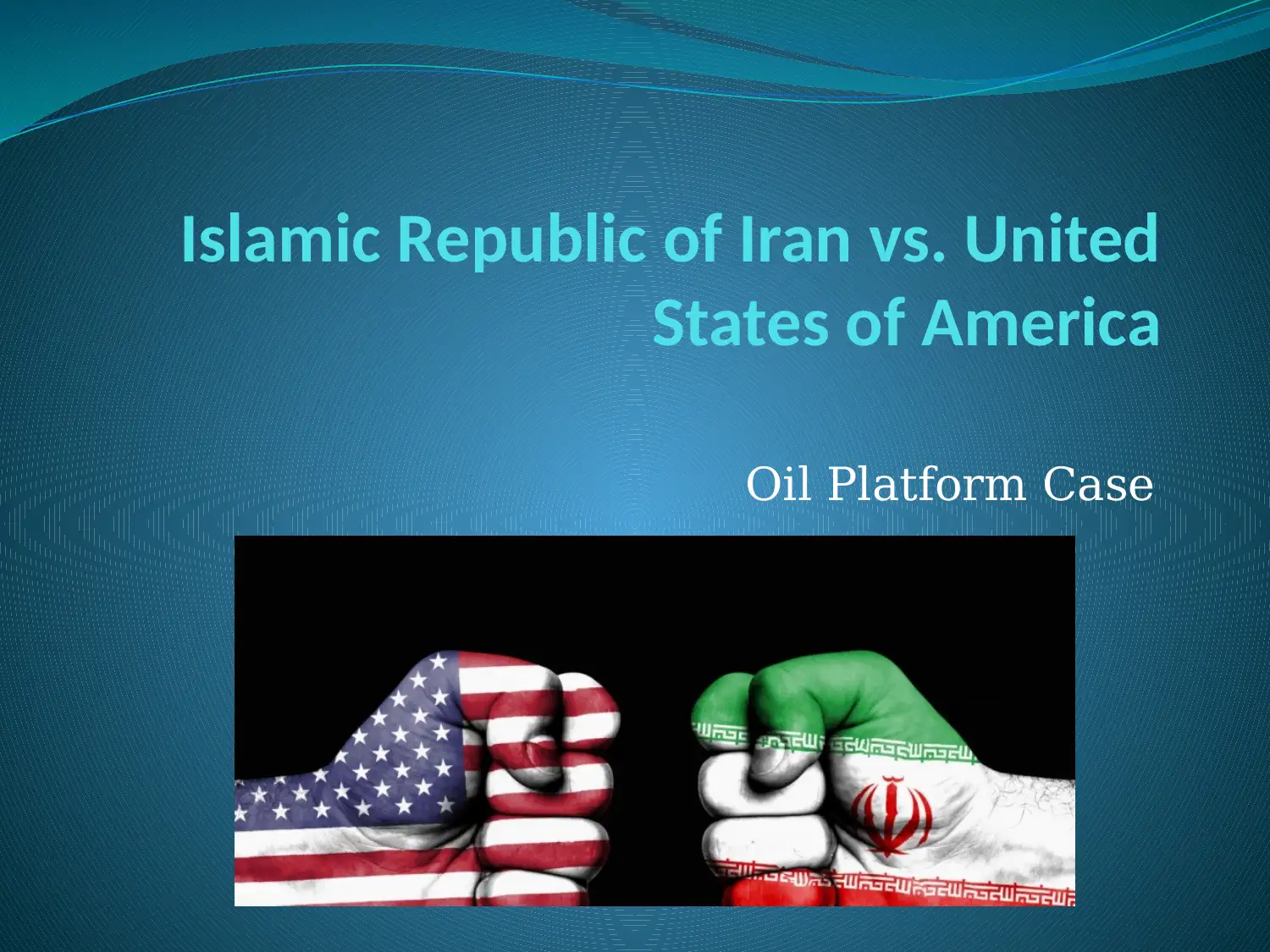
Islamic Republic of Iran vs. United
States of America
Oil Platform Case
States of America
Oil Platform Case
Secure Best Marks with AI Grader
Need help grading? Try our AI Grader for instant feedback on your assignments.
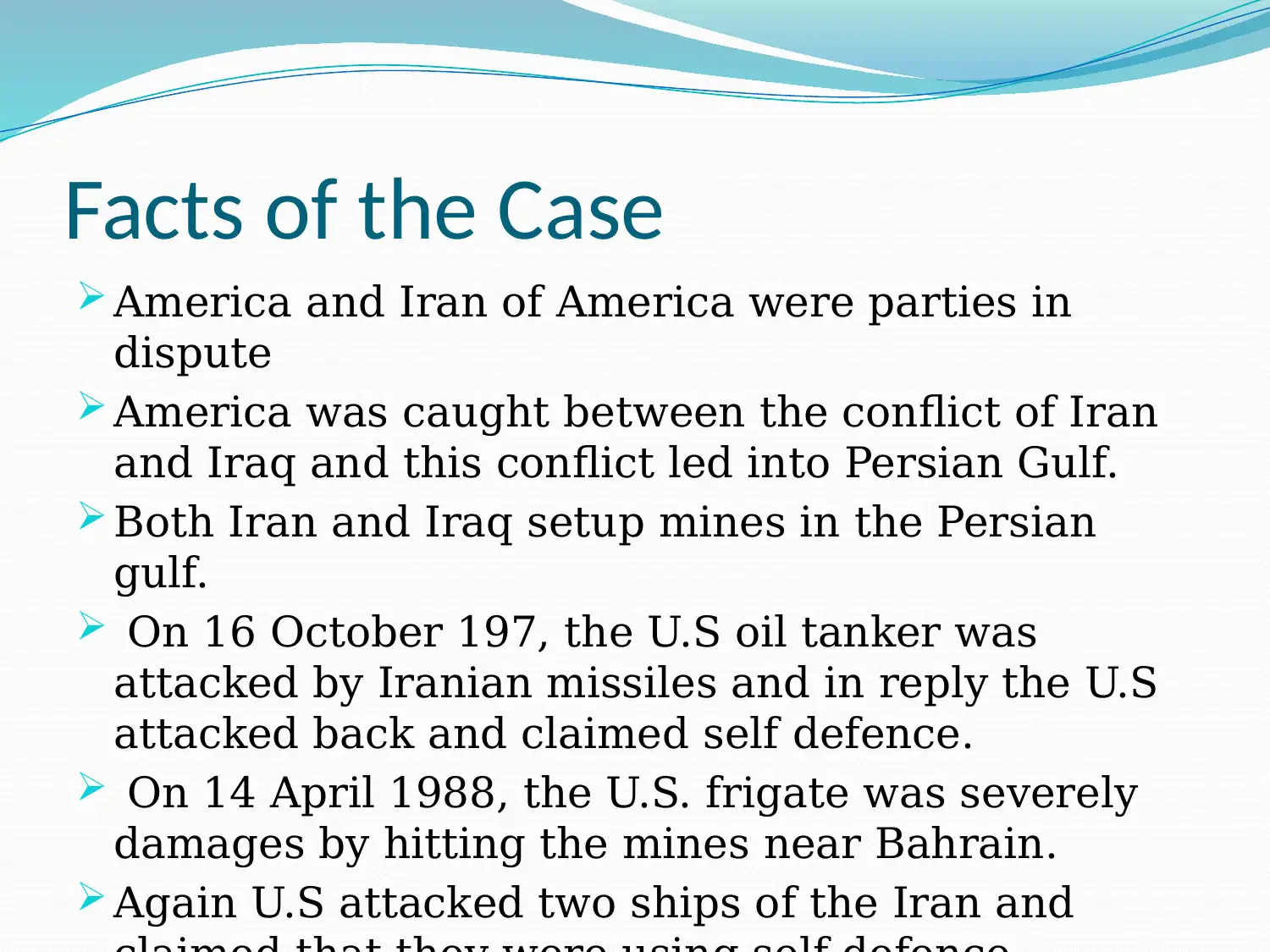
Facts of the Case
America and Iran of America were parties in
dispute
America was caught between the conflict of Iran
and Iraq and this conflict led into Persian Gulf.
Both Iran and Iraq setup mines in the Persian
gulf.
On 16 October 197, the U.S oil tanker was
attacked by Iranian missiles and in reply the U.S
attacked back and claimed self defence.
On 14 April 1988, the U.S. frigate was severely
damages by hitting the mines near Bahrain.
Again U.S attacked two ships of the Iran and
America and Iran of America were parties in
dispute
America was caught between the conflict of Iran
and Iraq and this conflict led into Persian Gulf.
Both Iran and Iraq setup mines in the Persian
gulf.
On 16 October 197, the U.S oil tanker was
attacked by Iranian missiles and in reply the U.S
attacked back and claimed self defence.
On 14 April 1988, the U.S. frigate was severely
damages by hitting the mines near Bahrain.
Again U.S attacked two ships of the Iran and
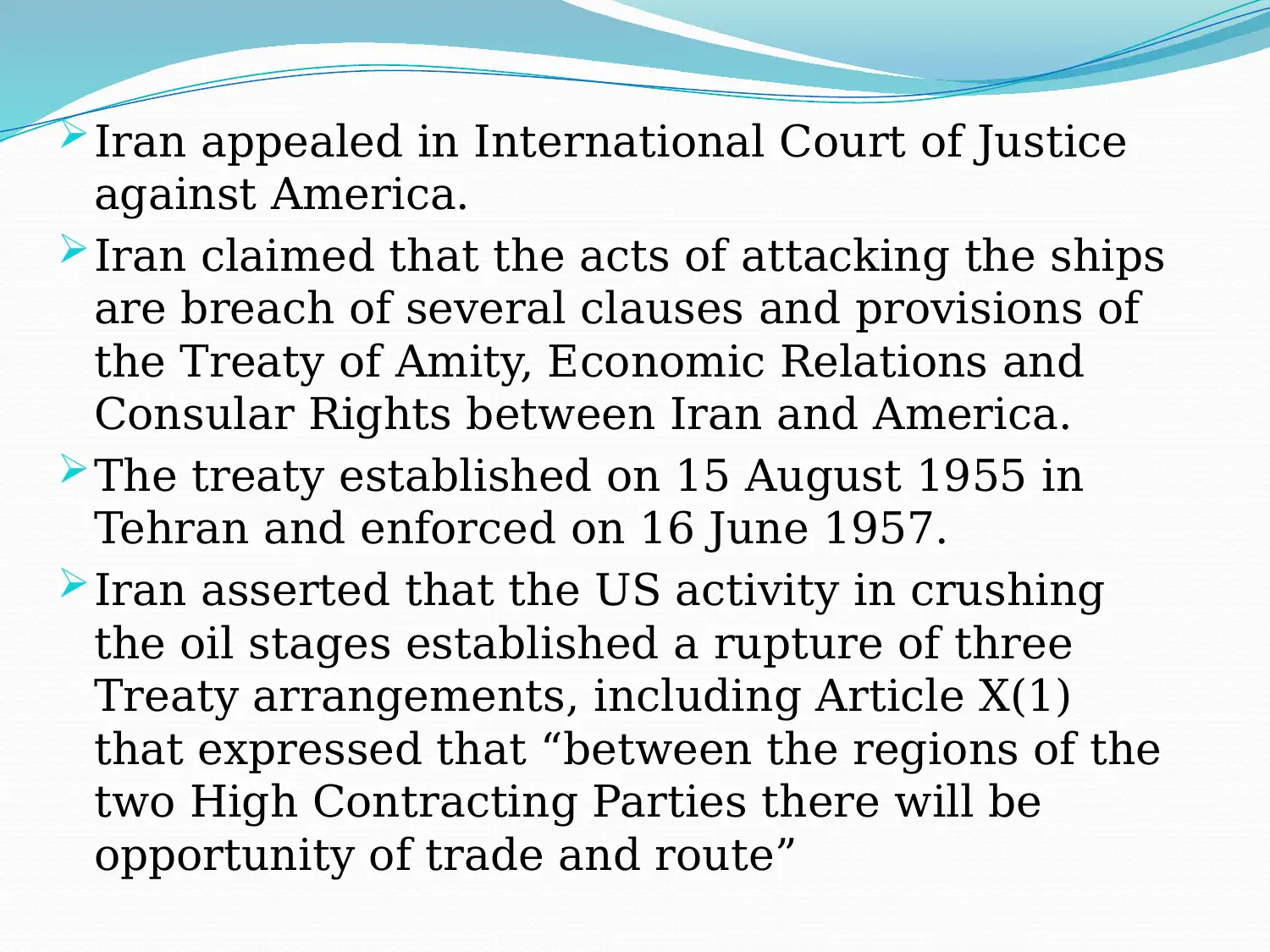
Iran appealed in International Court of Justice
against America.
Iran claimed that the acts of attacking the ships
are breach of several clauses and provisions of
the Treaty of Amity, Economic Relations and
Consular Rights between Iran and America.
The treaty established on 15 August 1955 in
Tehran and enforced on 16 June 1957.
Iran asserted that the US activity in crushing
the oil stages established a rupture of three
Treaty arrangements, including Article X(1)
that expressed that “between the regions of the
two High Contracting Parties there will be
opportunity of trade and route”
against America.
Iran claimed that the acts of attacking the ships
are breach of several clauses and provisions of
the Treaty of Amity, Economic Relations and
Consular Rights between Iran and America.
The treaty established on 15 August 1955 in
Tehran and enforced on 16 June 1957.
Iran asserted that the US activity in crushing
the oil stages established a rupture of three
Treaty arrangements, including Article X(1)
that expressed that “between the regions of the
two High Contracting Parties there will be
opportunity of trade and route”
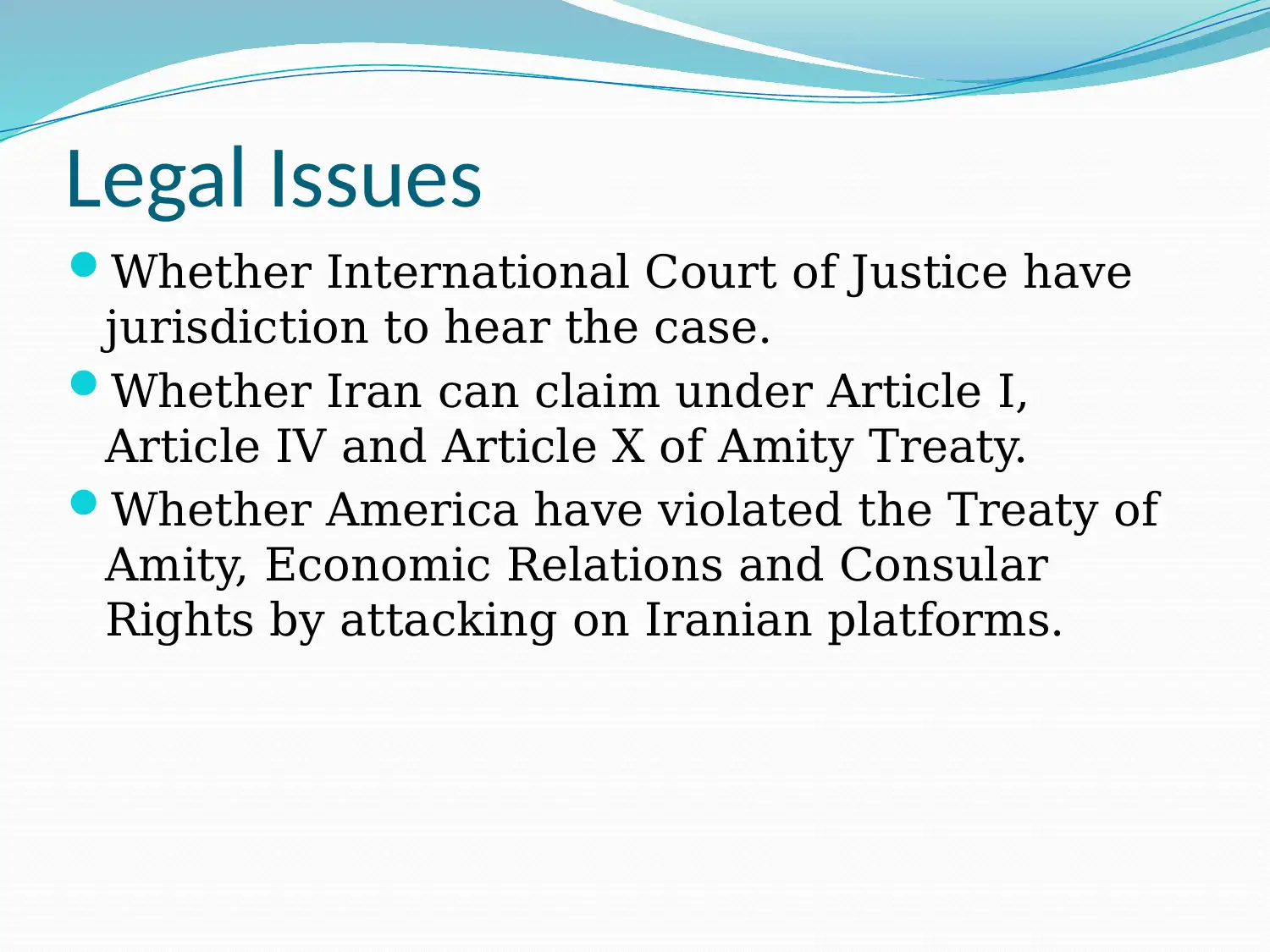
Legal Issues
Whether International Court of Justice have
jurisdiction to hear the case.
Whether Iran can claim under Article I,
Article IV and Article X of Amity Treaty.
Whether America have violated the Treaty of
Amity, Economic Relations and Consular
Rights by attacking on Iranian platforms.
Whether International Court of Justice have
jurisdiction to hear the case.
Whether Iran can claim under Article I,
Article IV and Article X of Amity Treaty.
Whether America have violated the Treaty of
Amity, Economic Relations and Consular
Rights by attacking on Iranian platforms.
Secure Best Marks with AI Grader
Need help grading? Try our AI Grader for instant feedback on your assignments.
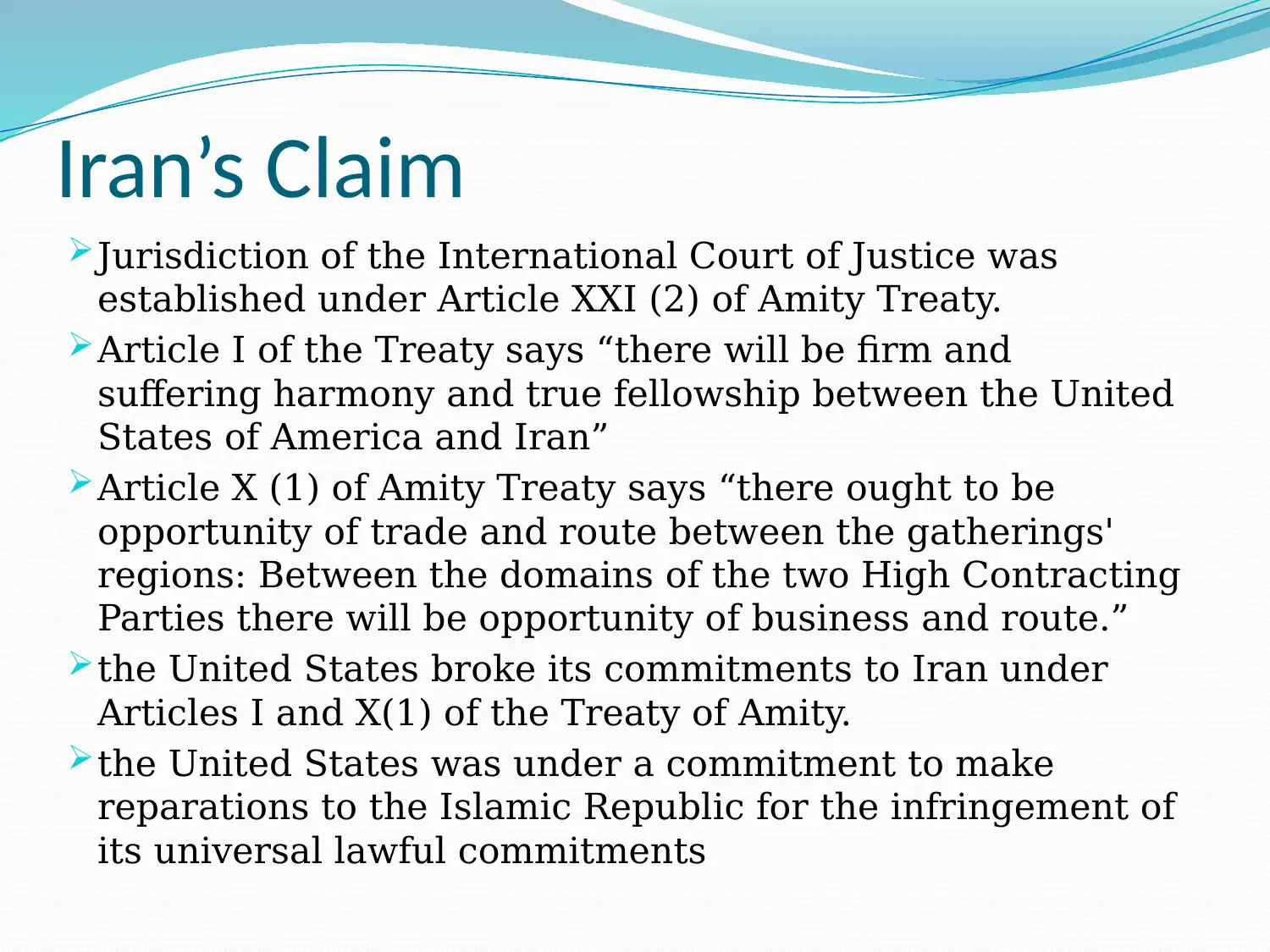
Iran’s Claim
Jurisdiction of the International Court of Justice was
established under Article XXI (2) of Amity Treaty.
Article I of the Treaty says “there will be firm and
suffering harmony and true fellowship between the United
States of America and Iran”
Article X (1) of Amity Treaty says “there ought to be
opportunity of trade and route between the gatherings'
regions: Between the domains of the two High Contracting
Parties there will be opportunity of business and route.”
the United States broke its commitments to Iran under
Articles I and X(1) of the Treaty of Amity.
the United States was under a commitment to make
reparations to the Islamic Republic for the infringement of
its universal lawful commitments
Jurisdiction of the International Court of Justice was
established under Article XXI (2) of Amity Treaty.
Article I of the Treaty says “there will be firm and
suffering harmony and true fellowship between the United
States of America and Iran”
Article X (1) of Amity Treaty says “there ought to be
opportunity of trade and route between the gatherings'
regions: Between the domains of the two High Contracting
Parties there will be opportunity of business and route.”
the United States broke its commitments to Iran under
Articles I and X(1) of the Treaty of Amity.
the United States was under a commitment to make
reparations to the Islamic Republic for the infringement of
its universal lawful commitments
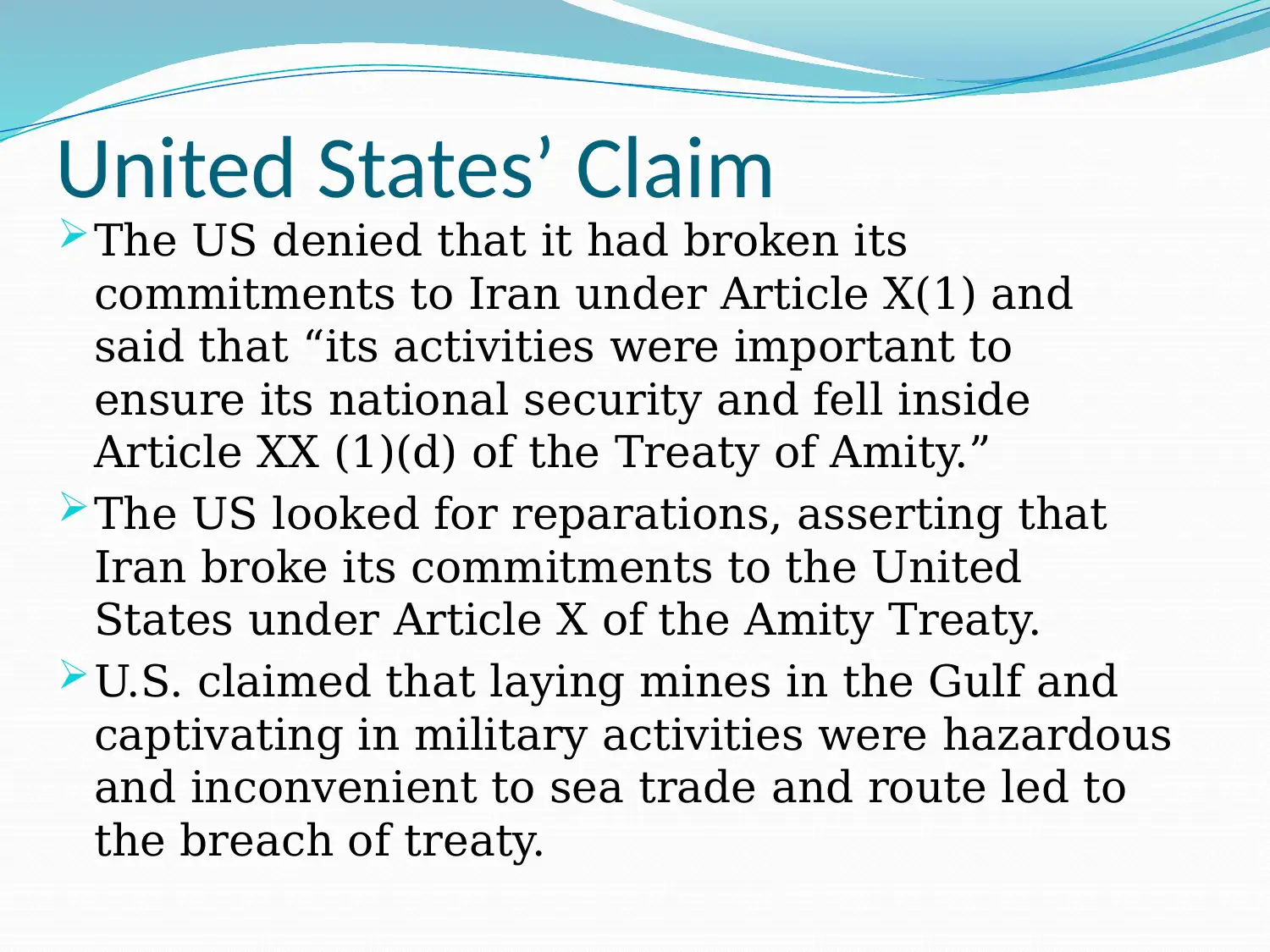
United States’ Claim
The US denied that it had broken its
commitments to Iran under Article X(1) and
said that “its activities were important to
ensure its national security and fell inside
Article XX (1)(d) of the Treaty of Amity.”
The US looked for reparations, asserting that
Iran broke its commitments to the United
States under Article X of the Amity Treaty.
U.S. claimed that laying mines in the Gulf and
captivating in military activities were hazardous
and inconvenient to sea trade and route led to
the breach of treaty.
The US denied that it had broken its
commitments to Iran under Article X(1) and
said that “its activities were important to
ensure its national security and fell inside
Article XX (1)(d) of the Treaty of Amity.”
The US looked for reparations, asserting that
Iran broke its commitments to the United
States under Article X of the Amity Treaty.
U.S. claimed that laying mines in the Gulf and
captivating in military activities were hazardous
and inconvenient to sea trade and route led to
the breach of treaty.
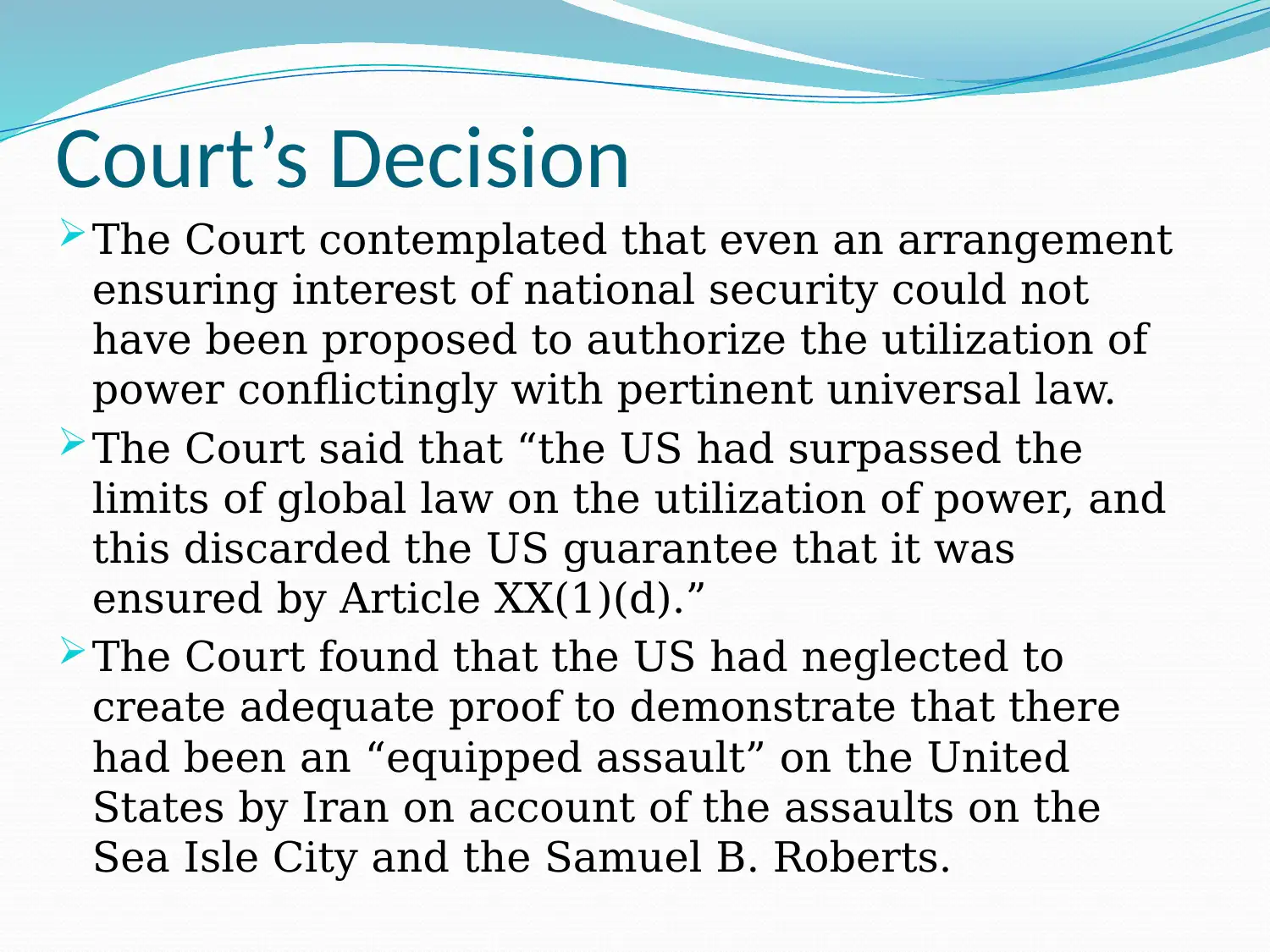
Court’s Decision
The Court contemplated that even an arrangement
ensuring interest of national security could not
have been proposed to authorize the utilization of
power conflictingly with pertinent universal law.
The Court said that “the US had surpassed the
limits of global law on the utilization of power, and
this discarded the US guarantee that it was
ensured by Article XX(1)(d).”
The Court found that the US had neglected to
create adequate proof to demonstrate that there
had been an “equipped assault” on the United
States by Iran on account of the assaults on the
Sea Isle City and the Samuel B. Roberts.
The Court contemplated that even an arrangement
ensuring interest of national security could not
have been proposed to authorize the utilization of
power conflictingly with pertinent universal law.
The Court said that “the US had surpassed the
limits of global law on the utilization of power, and
this discarded the US guarantee that it was
ensured by Article XX(1)(d).”
The Court found that the US had neglected to
create adequate proof to demonstrate that there
had been an “equipped assault” on the United
States by Iran on account of the assaults on the
Sea Isle City and the Samuel B. Roberts.
Paraphrase This Document
Need a fresh take? Get an instant paraphrase of this document with our AI Paraphraser
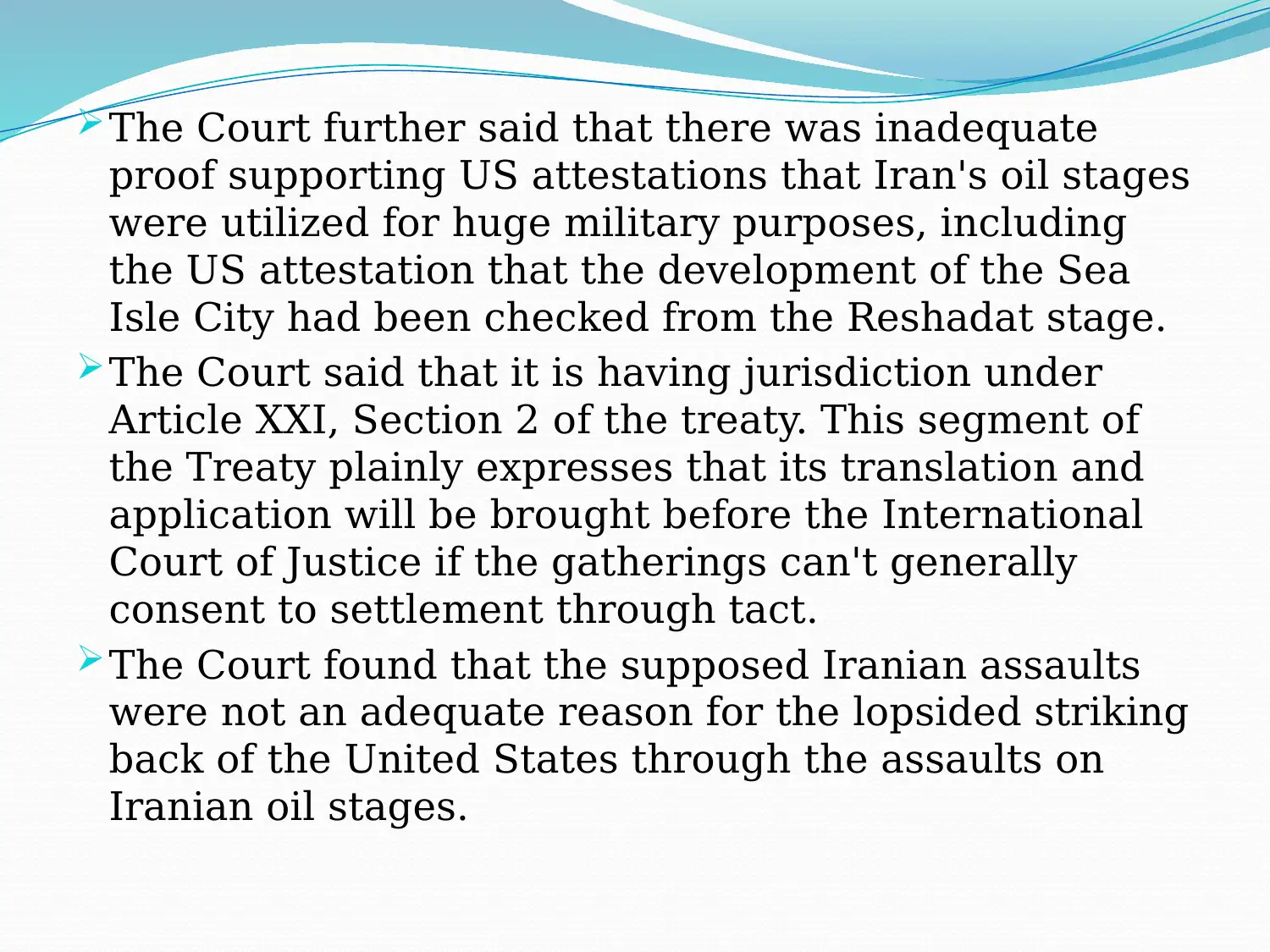
The Court further said that there was inadequate
proof supporting US attestations that Iran's oil stages
were utilized for huge military purposes, including
the US attestation that the development of the Sea
Isle City had been checked from the Reshadat stage.
The Court said that it is having jurisdiction under
Article XXI, Section 2 of the treaty. This segment of
the Treaty plainly expresses that its translation and
application will be brought before the International
Court of Justice if the gatherings can't generally
consent to settlement through tact.
The Court found that the supposed Iranian assaults
were not an adequate reason for the lopsided striking
back of the United States through the assaults on
Iranian oil stages.
proof supporting US attestations that Iran's oil stages
were utilized for huge military purposes, including
the US attestation that the development of the Sea
Isle City had been checked from the Reshadat stage.
The Court said that it is having jurisdiction under
Article XXI, Section 2 of the treaty. This segment of
the Treaty plainly expresses that its translation and
application will be brought before the International
Court of Justice if the gatherings can't generally
consent to settlement through tact.
The Court found that the supposed Iranian assaults
were not an adequate reason for the lopsided striking
back of the United States through the assaults on
Iranian oil stages.
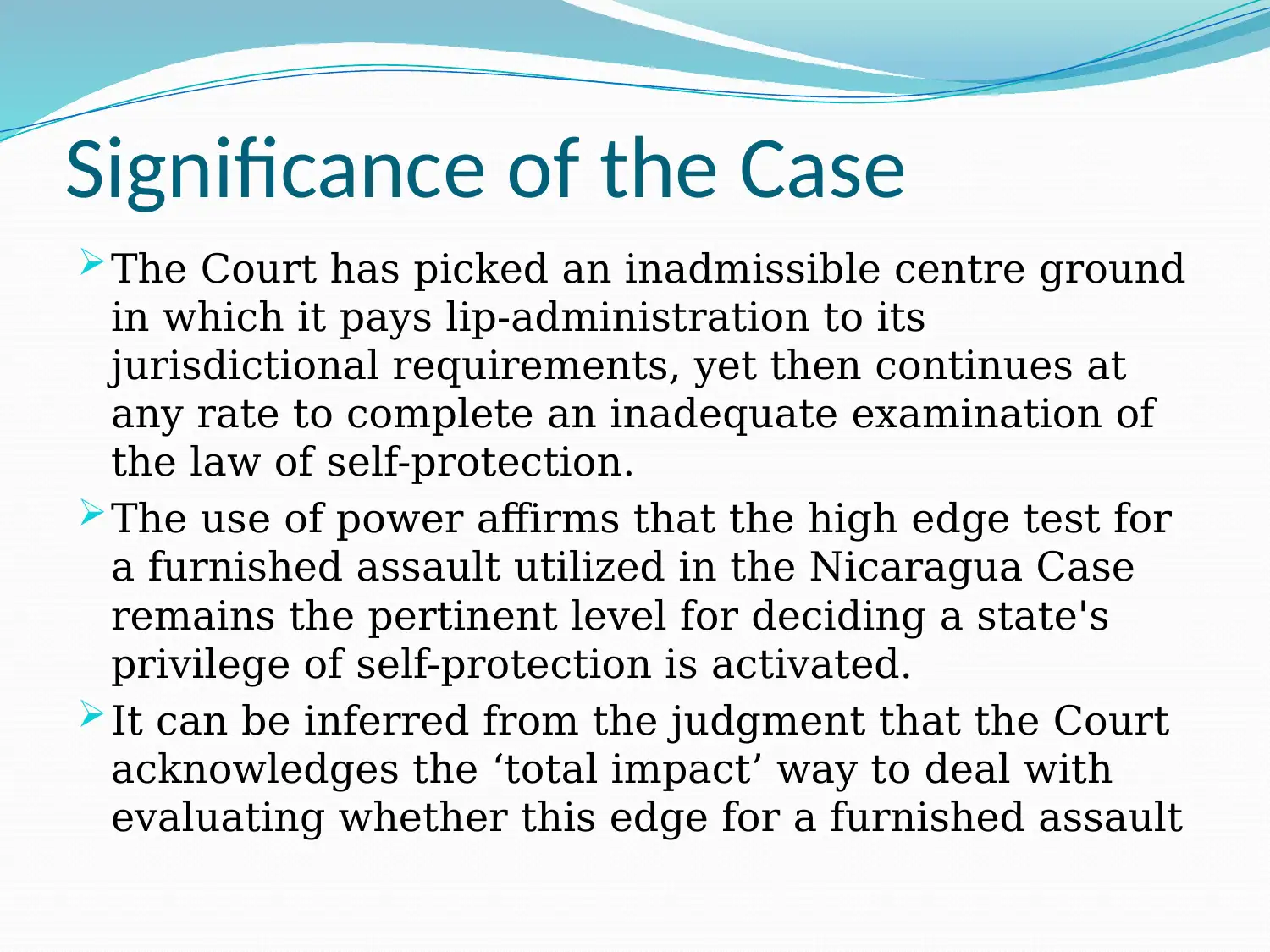
Significance of the Case
The Court has picked an inadmissible centre ground
in which it pays lip-administration to its
jurisdictional requirements, yet then continues at
any rate to complete an inadequate examination of
the law of self-protection.
The use of power affirms that the high edge test for
a furnished assault utilized in the Nicaragua Case
remains the pertinent level for deciding a state's
privilege of self-protection is activated.
It can be inferred from the judgment that the Court
acknowledges the ‘total impact’ way to deal with
evaluating whether this edge for a furnished assault
The Court has picked an inadmissible centre ground
in which it pays lip-administration to its
jurisdictional requirements, yet then continues at
any rate to complete an inadequate examination of
the law of self-protection.
The use of power affirms that the high edge test for
a furnished assault utilized in the Nicaragua Case
remains the pertinent level for deciding a state's
privilege of self-protection is activated.
It can be inferred from the judgment that the Court
acknowledges the ‘total impact’ way to deal with
evaluating whether this edge for a furnished assault
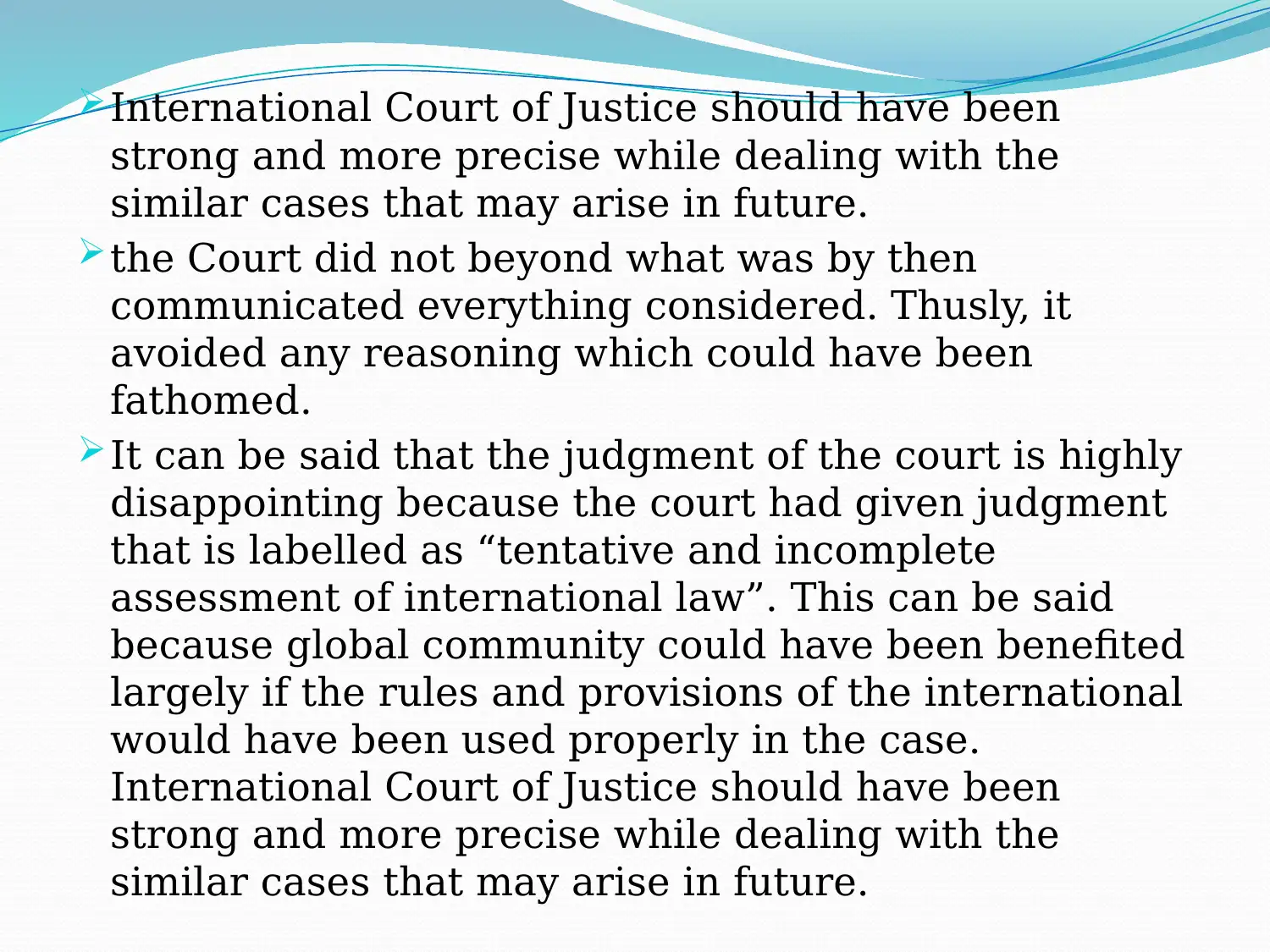
International Court of Justice should have been
strong and more precise while dealing with the
similar cases that may arise in future.
the Court did not beyond what was by then
communicated everything considered. Thusly, it
avoided any reasoning which could have been
fathomed.
It can be said that the judgment of the court is highly
disappointing because the court had given judgment
that is labelled as “tentative and incomplete
assessment of international law”. This can be said
because global community could have been benefited
largely if the rules and provisions of the international
would have been used properly in the case.
International Court of Justice should have been
strong and more precise while dealing with the
similar cases that may arise in future.
strong and more precise while dealing with the
similar cases that may arise in future.
the Court did not beyond what was by then
communicated everything considered. Thusly, it
avoided any reasoning which could have been
fathomed.
It can be said that the judgment of the court is highly
disappointing because the court had given judgment
that is labelled as “tentative and incomplete
assessment of international law”. This can be said
because global community could have been benefited
largely if the rules and provisions of the international
would have been used properly in the case.
International Court of Justice should have been
strong and more precise while dealing with the
similar cases that may arise in future.
1 out of 10
Your All-in-One AI-Powered Toolkit for Academic Success.
+13062052269
info@desklib.com
Available 24*7 on WhatsApp / Email
![[object Object]](/_next/static/media/star-bottom.7253800d.svg)
Unlock your academic potential
© 2024 | Zucol Services PVT LTD | All rights reserved.
